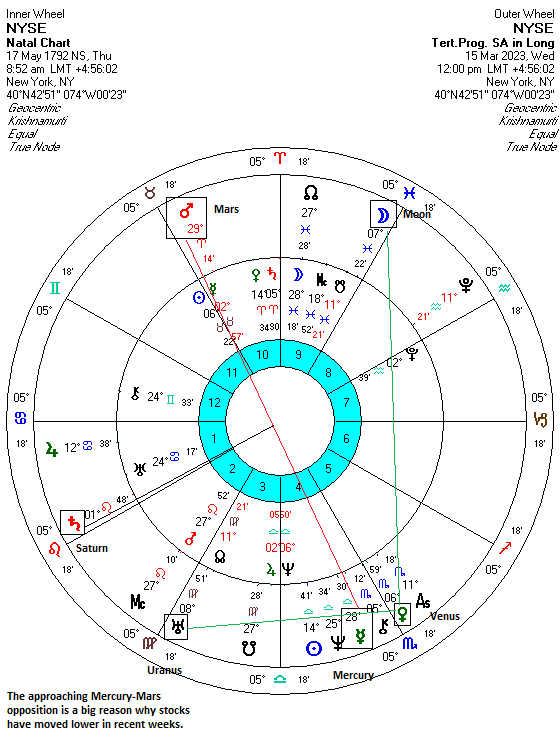(15 March 2023) One indispensable tool in the astrologer’s toolkit is the planetary progression. Progressed cycles, or progressions, are a Western astrological technique which yields unique information about future trends, both for financial markets and for individual life outcomes. Briefly stated, a progression moves a horoscope symbolically forward through time at particular rates that are based on the motion of the Sun and Moon. The more common secondary progression moves a horoscope forward at a rate of one calendar day for a year of life. So to determine the dominant influences on an individual’s life at the age of 30, we can progress the chart forward by 30 days from birth and analyze the key aspects and planetary placements with respect to the natal chart.
Less commonly used are the tertiary and minor progressions, which are calculated based on the motion of the Moon. A tertiary progression assumes the symbolic equivalence of one calendar day with one lunar month of life (about 27 days) while minor progressions equate one lunar month with one year of life, which produces a time compression factor of about 13. It is therefore possible to determine future trends based on the planetary positions of these progressions.
Progressions can therefore be thought of as time-gears, each having a different ratio. If the Sun-based secondary progression has a time-gear ratio of 1:365, tertiary progressions can be understood as a 27-day cycle with a compression ratio of 1:27, while the minor progression is a 13-day cycle with a time compression of 1:13. Shorter progressed cycles such as the 13-day minor progression are more responsive to the passage of time and are therefore more accurate for predictive purposes. And yet because they are faster-moving, they are less powerful in terms of decisively shaping outcomes. In this way, progressions adhere to the standard astrological principle that the slower the planet, the more powerful it is. However, the paradox is that the slower the planet, the more difficult it is to accurately predict the timing of its worldly manifestation.

By way of example, let’s take a look at the tertiary progressed 27-day cycle of the New York Stock Exchange chart (May 17, 1792). Currently, we can see there is one very close aspect of note: progressed Mercury (28Li30) is opposite progressed retrograde Mars (29Ar14). Tertiary progressions move much slower than transits, so it is important to remember that the motion a planet would move in one day equals about one month of clock time. Since Mercury moves a bit more than one degree per day, this equates to about one degree for every four weeks of clock time. Here Mars is retrograde and moving much more slowly — just one degree in three months. With the two planets moving towards each other, they will form an exact opposition on March 26.
As a rule, Mercury-Mars aspects are usually negative and the 180-degree opposition is especially so. The close proximity of this bearish aspect is one reason why stocks have been declining in recent weeks as the opposition tightens. The Moon-Venus-Uranus alignment could offer some relief in the near term, but it doesn’t look as strong. Also, the Moon moves much quicker and will only be within range for 2 or 3 days. And Tuesday’s bounce may well have used up some of its positive energy already. Once it moves away, the Venus-Uranus alignment likely won’t be close enough to offset the effect of the ongoing Mercury-Mars aspect.
While the March 26 date is significant for understanding the theoretical maximum of this bearish aspect, it does not necessarily mean that the stock market will bottom at that time. Other factors are also part of the overall equation, including transits, 13-day minor progressions, and indeed, other relevant charts (S&P 500, NASDAQ, etc.).
We would therefore have to reassess the overall market situation once the progressed opposition of Mercury and Mars begins to separate on March 27.
Nonetheless, the possible continuing of this bearish energy going into March 26 suggests a sustainable rebound is less likely in the coming days.
For more details, check out my weekly subscriber newsletter which is published every Sunday. In addition to reviewing the key planetary and technical influences on US and Indian stocks for the short and medium term, I also provide an astrological analysis of potential upcoming moves in currencies, gold and oil.
These updates are usually posted midweek. You can be notified of new posts by following me on Twitter.
Photo Credit: alex.ch




